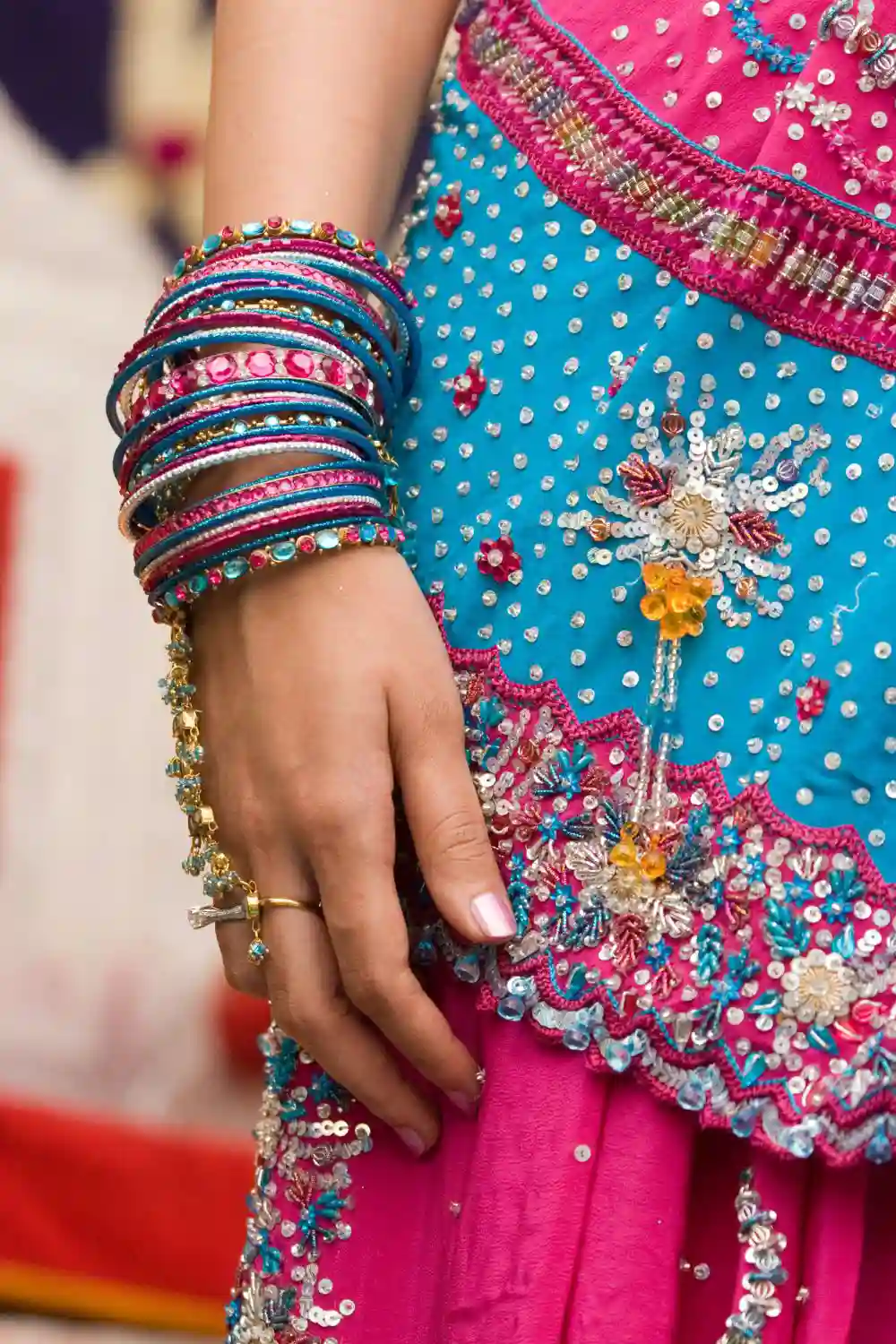Bangles have been integral to Indian women’s identity for ages, accentuating grace and beauty with their tinkle and shine. Their significance runs deep, shaped by various factors rooted in tradition, culture, religion, and superstition besides fashion and beauty.
Wearing bangles is traditionally etched in the Indian feminine psyche. Bangles mark marital status, promising prosperity and good health. Embodying Indian womanhood, bangles figure prominently in folklore and classical literature. Married women invariably wear bangles, evoking impressions of togetherness, devotion, and contentment.
The region a woman hails from impacts bangle-wearing styles – from designs and materials to the wrist they are worn on and the manner of wearing. Variations abound in color, shape, and ornamentation.
Diverse beliefs attach to bangles – some consider them auspicious, others as armor against the evil eye. After marriage, bangles accessorize women from weddings and festivals to religious ceremonies and daily chores.
Bangles accompany Indian women at every milestone, every celebration. They remain synonymous with femininity, spiritual solace, and resilience through thick and thin. Come high tides or happy times, bangles form a constant, providing continuity and comfort beyond fleeting fads.
Bangles are more than mere ornaments for Indian women – they signify traditions spanning generations, cultural practices passed down through the ages, and collective pearls of wisdom tied to taboos and superstitions. In them resides the essence of Indian womanhood.
So let’s get into all the reasons why Indian ladies wear bangles one by one.
Why do Indian ladies wear bangles?
Cultural and traditional reasons
Bangles are intrinsic to Indian women’s fashion, culture, and tradition. Ladies wear bangles for various reasons deeply rooted in Indian history and heritage.
For Indian women, bangles symbolize beauty, marital status, and prosperity. Married ladies generally wear them as a sign of their marital bond. The tradition dictates that newlyweds wear 21 bangles while ladies with children wear 24 bangles. The more bangles, the higher the woman’s social status.
Bangles representing different colors signify diverse meanings. Green bangles indicate fertility and good fortune. Red bangles convey marital happiness, while golden and colorful bangles symbolize wealth and prosperity.
As per Indian customs, bangles are an essential part of ‘Solah Shringaar’, the 16 traditional ornaments each married woman wears. They complement saris, suits, and Indian dresses.
In South India, wearing green glass bangles after marriage for 21 to 41 days is a must ritual that ensures the well-being of the newly wedded couple.
In summary, bangles indicate the social status, age, and marital status of an Indian woman. They align with Indian traditions and envision cultural and religious beliefs that classify womanhood and prosperity. For Indian ladies, wearing bangles is more than an ornament; it is an identity.

Matrimonial significance
Indian brides wear bangles as a symbol of their marital status and womanhood. Bangles have immense matrimonial value in Indian culture and tradition.
For Indian brides, donning decorated glass bangles is mandatory before marriage ceremonies. The act of breaking these bangles during wedding rituals shows she has left her parental home to start a new life as a wife. This symbolizes the start of her married life and brings prosperity.
Bangles are seen as a symbol of protection. The husband purchases bangles for his wife as a reflection of his love and commitment. The wife wears them as a sign that she now falls under her husband’s shield.
Donning bangles is considered necessary for would-be brides and newlywed women for the long life of their husbands. Girls and unmarried ladies refraining from wearing bangles are seen as inauspicious.
Bangles form part of the Solah Shringaar, the traditional sixteen ornaments that every married woman adorns. The more bangles she wears, the greater the family’s prosperity and her social status as a married woman.
Bangles made using lac, a resin believed to have protective qualities, worn by brides during wedding ceremonies seek to ward off evil spirits and attract positive energy for the couple.
In summary, bangles hold immense value as a sign of women’s marital status and transition to wifehood in Indian culture. The act of breaking glass bangles during weddings brings prosperity and attracts positive energy for the couple starting their married life.
Religious reasons
Bangles hold religious significance for Indian women, especially in Sikhism and Hinduism. They are seen as a symbol of faith and devotion, and wearing them during religious rituals honors one’s religion.
In Hinduism, bangles carry religious values. Married Hindu women wear lac bangles as a sign of suhaag (marital happiness). The sound of bangles is believed to attract good fortune and prosperity to the family. Bangles are also seen as a symbol of fertility and are used to ward off evil spirits, especially during pregnancy.
During Hindu festivals like Holi, women wear colorful bangles to celebrate. Wearing bangles during the festival honors their religion.
In Sikhism, the kara is an important religious symbol. It is an iron bangle worn by both men and women to symbolize faith and purity. Sikhs must always wear the kara as one of the five articles of the faith.
Bangles form an essential part of an Indian bride’s trousseau as part of her 16 traditional ornaments known as Solah Shringar. They complement Indian wedding attires.
In summary, bangles carry religious value for Indian women, especially in Sikhism and Hinduism. Married Hindu women wear bangles as a sign of suhaag, symbolizing marital happiness and prosperity. For Sikhs, the kara bangle symbolizes their faith and purity. And during religious rituals and festivals, Indian women wear bangles to honor their religion.
Beauty and fashion
Bangles are an essential part of Indian women’s jewelry and fashion aesthetics. Women wear colorful bangles to enhance their inherent beauty and exhibit style as dictated by Indian traditions.
Bangles come in multitudes of designs, colors, and materials. Their shapes and hues hold symbolic meanings. Red symbolizes love, while green indicates prosperity. Different types are worn depending on age, occasion, and region.
Bangles complement Indian attires like saris, lehengas, and salwar suits. They highlight feminine grace, poise, and Indian womanhood as portrayed in literature. Bangles are considered an integral part of a woman’s personality and identity.
Women wear bangles to match the aesthetics of different occasions. They adorn colorful bangles during festivals to add glamour. Bridal bangles in gold and jewelry embellished with precious stones harmonize with bridal outfits during weddings.
Bangles aren’t merely ornaments for Indian women. Married women need to don bangles as a symbol of their marital status. Wearing bangles affirms one’s womanhood in traditional Indian society.
Girls are allowed to wear simple bangles, but married women typically favor decorative varieties to exhibit their womanly elegance.
In summary, through their myriad hues, components, shapes, and designs, bangles significantly emphasize Indian women’s fashion sense and beauty aesthetics. They help women match the mood of various occasions and exhibit their unique personalities as prescribed by Indian traditions that classify womanhood.

Health benefits
Indian women wear bangles as they believe it contributes to their overall health and well-being based on the principles of Ayurveda, the ancient Indian medicine system.
The constant rubbing of bangles on wrists improves blood circulation, which helps keep the body healthy. The friction stimulates the nerves and veins in the wrists, regulating the pulse and easing blood flow. This may reduce blood pressure and recharge energy levels.
The sound of bangles hitting each other and the wrists is thought to reduce stress and improve mood by providing a soothing and calming effect.
It is also believed that wearing bangles strengthens the wrists and hands’ bones, helping maintain good health, especially as women age. Studies suggest ladies wearing bangles experience less fatigue and health issues than those who do not.
Bangles are also regarded as protecting against evil spirits as the sound is thought to scare them away. This positive spiritual association contributes to overall well-being.
While these health benefits of wearing bangles exist in Indian beliefs, rigorous scientific research is still lacking.
The cultural factors behind Indian women’s use of bangles, beyond potential health benefits, should also be considered. Wearing bangles indicates marital status, prosperity, and auspiciousness.
In summary, Indian women wear bangles believing it improves blood circulation, reduce stress, strengthen bones, and wards off evil, but limited robust scientific evidence exists. The tradition, rooted in culture and spirituality, gives women a sense of psychological well-being aligned with ancient Indian health principles. The effect likely stems more from its positive associations than tangible physiological impacts.
Regional differences
Bangle styles, materials, and wearing traditions vary widely across Indian states reflecting regional diversity in culture and traditions.
In southern states like Tamil Nadu, women wear green glass bangles after marriage to symbolize fertility and prosperity. In Punjab, brides wear a set of red bangles called ‘choora’ for up to a year post-wedlock.
The number of bangles can denote a women’s marital status. In Hindu culture, married women wear multiple bangles to showcase they are ‘suhaagan’ or wedded.
Bangles are made of diverse materials to fit distinct regional aesthetics. Glass bangles are considered the most auspicious in pan-India culture. However, women also wear gold, silver, metal, and ivory bangles, matching native sensibilities.
Bangle designs differ by region. In Rajasthan, women favor broad silver bangles with intricate motifs reflecting the state’s jewelry craft. In Gujarat, thin, brightly-hued glass bangles harmonize with colorful traditional attires.
Regional diversity also exists in wearing styles. South Indian women generally sport bangles on both wrists, while North Indian women favor the left wrist. Bangles can also be worn tightly or loosely in different regions.
In summary, striking variations exist in the styles, materials, designs, and wearing traditions of bangles across Indian states, reflecting diverse cultural ethos, aesthetic senses, rituals, and fashion trends shaped by unique regional histories. The vast diversity of bangles worn by women in different parts of India adds to the richness of the country’s cultural manifold.
To ward off the evil eye
Indian women wear bangles to protect against the evil eye, believed to be caused by envy, jealousy, or excessive admiration.
Bangles are thought to ward off the evil eye due to their shiny, reflective nature. When moved or tapped together, their sound is believed to scare away evil spirits.
Indian women often wear bangles as a precautionary measure against the evil eye. Those considered vulnerable, like children, pregnant women, and new mothers, commonly wear bangles for protection.
Bangles promote spiritual and physical well-being beyond warding off the evil eye. Their continuous tapping is said to improve blood circulation, normalize blood pressure, and recharge energy levels, though no scientific evidence supports these claims.
Wearing bangles is associated with the planet Venus in Indian astrology, but the belief in bangles protecting against the evil eye stems more from culture than astrology.
Regional variations in bangle-wearing styles and designs across Indian states reflect diverse interpretations of their symbolic roles. For example, in some cultures, the number of bangles worn indicates marital status.
In summary, Indian women traditionally wear bangles for protection against the evil eye based on cultural beliefs rather than scientific evidence. Glittering bangles believed to scare away evil spirits are viewed as safeguarding physical and spiritual well-being beyond warding off curses. The regional differences in bangle-wearing traditions highlight diverse perspectives and symbolisms aligned with India’s cultural diversity.
To celebrate a special occasion
Indian women wear bangles during celebrations to honor important life events in keeping with cultural traditions.
Indian weddings represent the most ubiquitous bangle-wearing occasion. It is customary for brides to don bangles made of glass, gold, or other metals as these accessories symbolize their new marital status and invoke wishes for their husband’s longevity. Bangles comprise an essential element of the 16 traditional bridal ornaments known as Solah Shringaars.
Bangles are also worn during festivals and religious ceremonies to adhere to customary attire and honor one’s faith. During Holi, for example, women wear colorful bangles to celebrate the feast day.
The type and number of bangles worn may vary by occasion. A newlywed woman may don 21 bangles, while one with children dons 24.
Beyond weddings and festivals, bangles are worn during other momentous occasions like birthdays and anniversaries. They elevate one’s beauty and style while adding flair to one’s attire.
Bangles help Indian women commemorate significant life junctures in culturally appropriate ways. Donning them draws one into the tradition, connecting them with their heritage. The bangles themselves transform into mementos reflecting the joyous occasion.
In summary, Indian women wear bangles during large and small celebrations to honor important life events as their traditions dictate. Bangles, through their vibrant colors and tinkling sounds, infuse optimism and mirth into the celebrations while helping women express joy in culturally resonant ways.

Summary
Indian women have worn bangles for generations as a way to express femininity, cultural identity, and religious values. There are numerous reasons why bangles hold such significance for Indian women.
Traditionally, bangles mark a woman’s marital status and symbolize prosperity, fertility, and spirituality. They indicate various aspects of a woman’s identity based on cultural norms and practices handed down through generations. The colors, materials, and number of bangles provide clues about a woman’s age, marital status, and social standing.
Bangles play an important role in religious ceremonies and special occasions. They are part of traditional wedding attire for brides and add vibrancy to festivals like Holi. The regional variations in bangle styles reflect the cultural diversity of India.
For Indian women, bangles are more than just jewelry – they signify cultural values and traditions that are intrinsically linked with notions of womanhood, marital happiness, and auspiciousness. Bangles have been a constant accessory throughout the ages, providing comfort through their symbolic power and simple aesthetic beauty.
Bangles hold deep significance for Indian women as carriers of cultural history, tradition, and religious beliefs that shape conceptions of womanhood, prosperity, and spiritual well-being. Gearing bangles offers women a sense of continuity, identity, and connection to their female ancestors and community.
FAQ
What is the history of bangles in India?
Bangles have a rich history in India, dating back thousands of years. The earliest discovery of bangles dates back to around 2600 B.C. in the Mohenjo-Daro settlements. They were worn by both men and women as decorative ornaments and a symbol of social status. Historically, bangles have been made from various materials, including copper, gold, silver, glass, wood, and plastic.
Can unmarried girl wear green bangles?
Yes, unmarried girls can wear green bangles. No cultural or traditional restriction limits wearing green bangles to married women only. Green bangles are a popular choice in India and are associated with fertility, good luck, and protection from evil spirits. As with any accessory, the decision to wear green bangles is a personal choice based on individual beliefs and preferences.
How many bangles should a bride wear?
The number of bangles a bride should wear varies based on cultural and regional customs. In some traditions, a bride might wear a set of 21 bangles, while in others, the number may not be as specific. The choice of the number of bangles is a personal decision, reflecting the bride’s preferences and beliefs. Safety, comfort, and cultural significance should be considered when selecting the perfect number of bangles for the wedding day.
What is the importance of lakh bangles?
Lakh bangles hold significant cultural importance in India. They are made from lac, symbolizing marital status and prosperity. Newly married women wear them, and the number of bangles indicates their status. Lakh bangles are believed to attract positive energy and protect against evil spirits. They are given as gifts during weddings, festivals, and religious ceremonies. With their intricate designs and various colors, lakh bangles represent a beautiful expression of cultural heritage and celebration of special occasions in India and beyond.
Which place in India is famous for bangles?
Firozabad, Uttar Pradesh, is renowned for its bangles and is called the “glass city” of India. It has a history of glass bangle production dating back to the 16th century. The city’s special “firazabadi glass” is used to make bangles known for their clarity, brilliance, and durability. The labor-intensive process involves melting the glass, pouring it into molds, cooling it, and then polishing and decorating the bangles. Firozabad remains a significant hub for bangle manufacturing with various colors and designs.



